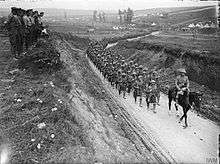7th Infantry Division (United Kingdom)
| 7th Division 7th Infantry Division | |
|---|---|
 | |
| Active |
1914–1919 October 1938–November 1939 |
| Country |
|
| Branch |
|
| Type | Infantry |
| Size | Division |
| Engagements |
Peninsular War Battle of Fuentes de Onoro Battle of Vitoria Battle of the Pyrenees Battle of Nivelle Battle of the Nive Battle of Orthez First World War First Battle of Ypres Battle of Neuve Chapelle Battle of Aubers Ridge Battle of Festubert Battle of Loos Battle of the Somme Battle of Passchendaele Battle of Vittorio Veneto |
The 7th Infantry Division was an infantry division of the British Army, first established by The Duke of Wellington as part of the Anglo-Portuguese Army for service in the Peninsular War, and was active also during the First World War from 1914–1919, and in the Second World War from 1938–1939 in Palestine and Egypt.
Peninsular War
The 7th Division was formed during the Peninsular War by Arthur Wellesley, 1st Duke of Wellington, and was present at the Battle of Fuentes de Onoro the Battle of Vitoria the Battle of the Pyrenees the Battle of Nivelle the Battle of the Nive and the Battle of Orthez. The composition of the 7th Division in the Peninsular War was as follows:
Peninsular War order of battle
- Commanding officer Major General Hope, then Lord Dalhousie, and from 1813 General Lecor
- 1st Brigade: commanded by Colonel Colin Halkett
- 1st Light Battalion, King's German Legion (to December 1812)
- 2nd Light Battalion, King's German Legion (to December 1812)
- 1/6th (1st Warwickshire) Regiment of Foot (from November 1812)
- 3rd Provisional Battalion (2/24th and 2/58th Regiments of Foot) (from December 1812)
- 7 Coys, Brunswick-Oels
- 2nd Brigade: commanded by Major General de Bernewitz
- 51st (2nd Yorkshire West Riding) Regiment of Foot (Light Infantry)
- 68th (Durham) Regiment of Foot (Light Infantry) (from July 1811)
- 1/82nd Regiment of Foot (Prince of Wales's Volunteers) (from November 1813)
- 85th (Bucks Volunteers) Regiment of Foot (Light Infantry) (to October 1811)
- Chasseurs Britanniques
- Portuguese Brigade: commanded by Colonel Collins, from 1813 by Colonel Doyle
- 1/7th Portuguese Line
- 2/7th Portuguese Line
- 1/19th Portuguese Line
- 2/19th Portuguese Line
- 2nd Caçadores.
Second Boer War
The 7th Division was re-activated during the 2nd Boer War. Its composition in May and June 1900 was as follows:[1]
2nd Boer War order of battle
- General Officer Commanding: Lt-Gen C. Tucker
14th Brigade Maj-Gen J.G. Maxwell
- 2nd Bn Norfolk Regiment
- 2nd Bn Lincolnshire Regiment
- 1st Bn King's Own Scottish Borderers
- 2nd Bn Hampshire Regiment
15th Brigade Maj-Gen A.G. Wavell
- 2nd Bn Cheshire Regiment
- 1st Bn East Lancashire Regiment
- 2nd Bn South Wales Borderers
- 2nd Bn North Staffordshire Regiment
Artillery
- 18th Battery, Royal Field Artillery
- 62nd Battery, RFA
- 75th Battery, RFA
- Two 9.45-inch howitzers
- Six 6-inch howitzers
Mounted Troops
- 1 Company, City Imperial Volunteers Mounted Infantry
- Nesbitt's Horse
Engineers
- 26th Company, Royal Engineers.
First World War
The 7th Division was a Regular Army formation that was formed in September 1914 by combining units returning from garrison outposts in the British Empire at the outbreak of the First World War the previous month.[2][3] The division landed at Zeebrugge in Belgium on 6 October 1914 in an attempt to support the Belgian Army’s defence of Antwerp, but was soon forced to retreat south-west as that city fell a few days later. It then played a crucial part in the stabilization of the front during the First Battle of Ypres, preventing a German breakthrough, although at a high cost in terms of casualties.[4]

The 7th Division fought in most of the major battles on the Western Front through to 1917 before being sent to the Italian Front for the remainder of the war. At the battle of Loos in late 1915, the division’s General Officer Commanding (GOC), Major-General Thompson Capper, was killed in action at the height of the fighting. Unlike the first six regular divisions of the British Expeditionary Force (BEF), a third of whose strength was made up of regular reservists, the 7th Division was originally composed entirely of serving regular soldiers, which gave rise to the division's nickname, ‘The Immortal Seventh’.
First World War order of battle
The composition of the 7th Division during the First World War was as follows:[2][3]
- 2nd Battalion, Border Regiment
- 2nd Battalion, Gordon Highlanders
- 1st Battalion, Grenadier Guards (left August 1915)
- 2nd Battalion, Scots Guards (left August 1915)
- 1/6th Battalion, Gordon Highlanders (until January 1916)
- 8th (Service) Battalion, Devonshire Regiment (from May 1915)
- 9th (Service) Battalion, Devonshire Regiment (from August 1915)
- 2nd Battalion, Bedfordshire Regiment
- 2nd Battalion, Alexandra, Princess of Wales's Own (Yorkshire Regiment)
- 2nd Battalion, Royal Scots Fusiliers
- 2nd Battalion, Duke of Edinburgh's (Wiltshire Regiment)
- 1/4th Battalion, Queen's Own Cameron Highlanders (from April 1915, left December 1915)
The brigade transferred to the 30th Division on 19 December 1915, swapping with the 91st Brigade.
- 1st Battalion, Royal Welch Fusiliers
- 2nd Battalion, Royal Warwickshire Regiment
- 1/8th Battalion, Royal Scots (Lothian Regiment) (until August 1915)
- 1/7th Battalion, King's (Liverpool Regiment) (from November 1915 until January 1916)
- 2nd Battalion, Queen's (Royal West Surrey Regiment) (left December 1915)
- 1st Battalion, South Staffordshire Regiment (left December 1915)
- 20th (Service) Battalion (5th City), Manchester Regiment (from December 1915)
- 24th (Service) Battalion (Oldham), Manchester Regiment (from December 1915; became divisional pioneers 22 May 1916)
- 2nd Battalion, The Royal Irish Regiment (from May 1916 until October 1916)
- 2/1st Battalion, Honourable Artillery Company (from October 1916)
- 2nd Battalion, Queen's (Royal West Surrey Regiment) (from December 1915)
- 1st Battalion, South Staffordshire Regiment (from December 1915)
- 20th (Service) Battalion (5th City), Manchester Regiment (left December 1915)
- 21st (Service) Battalion (6th City), Manchester Regiment
- 22nd (Service) Battalion (7th City), Manchester Regiment
- 24th (Service) Battalion (Oldham), Manchester Regiment (left December 1915)
- 1/4th Battalion, Queen's Own Cameron Highlanders (from December 1915 until January 1916)
The brigade joined from the 30th Division in December 1915, swapping with the 21st Brigade. A number of battalions swapped to the brigade from other 7th Division brigades during the transition.
- Artillery
- XIV Brigade, Royal Horse Artillery (left to become XIV Army Brigade, RHA on 10 February 1917)
- C Battery, RHA (to 19 October 1914)
- F Battery, RHA
- T Battery, RHA (from 21 December 1914)
- 57th (Howitzer) Battery, RFA (from 27 November 1914 to 2 March 1915)
- D(H)/XIV Battery, RFA (from 17 May 1916)
- 509th (H) Battery, RFA (from 7 October 1916 to 13 February 1917)
- XIV RHA Brigade Ammunition Column
- XXII Brigade, Royal Field Artillery
- XXXV Brigade, Royal Field Artillery
- XXXVII (Howitzer) Brigade, Royal Field Artillery (from 24 June 1915, broken up 17 May 1916)
- III Heavy Brigade, Royal Garrison Artillery (until 4 March 1915)
- 111 Heavy Battery RGA
- 112 Heavy Battery RGA
- Engineers[5]
- 54th Field Company, Royal Engineers
- 55th Field Company, RE (until 1 September 1915)
- 95th Field Company, RE (from 30 August 1915)
- 2nd Highland Field Company, RE (joined 17 January 1915; to 51st (Highland) Division 24 January 1916)
- 3rd Durham Field Company, RE (joined from 51st (Highland) Division 30 January 1916; renumbered 528th (Durham) Field Company 3 February 1917)
- Pioneers
- 24th (Service) Bn Manchester Regiment (from 22 May 1916).
Battles during the First World War
- First Battle of Ypres
- Battle of Neuve Chapelle
- Battle of Aubers Ridge
- Battle of Festubert
- Battle of Loos
- Battle of the Somme
- Battle of Passchendaele
- Battle of Vittorio Veneto
Second World War
Richard O'Connor served as Military Governor of Jerusalem and General Officer Commanding, 7th Infantry Division, in Palestine and Egypt from 29 September 1938 to 3 November 1939.[6] When O’Connor was formally appointed on 4 October 1938, the division had not yet been fully formed,[7] but the 19th Infantry Brigade had been earmarked for the new formation.
The Times noted on 19 October 1938 that, “There will be enough infantry to give ... two divisions [the other apparently being the 8th Infantry Division]. Already on duty are the 14th, 16th, 17th and 19th Brigades, the brigade from India, and one made up from home and Malta. Soon there will be added units of a mounted brigade.”[8] The composition of the division just prior to the outbreak of war was as follows:[9]
Second World War order of battle
Cavalry
- Royal Scots Greys (Rehovot, near Tel Aviv)
Infantry
- 19th Infantry Brigade (became HQ Jerusalem Area on 3 September 1939)[10]
- 2nd Bn West Yorkshire Regiment
- 2nd Bn Highland Light Infantry
Engineers
- 56 Field Company, Royal Engineers
Division HQ moved from Jerusalem to Cairo on 31 August 1939, giving up command of the above troops and taking over the troops in the Cairo area (the Cairo Brigade became the 29th Infantry Brigade on 20 September 1939). 7th Division HQ then moved to Mersa Matruh on 4 September, taking over all troops in the area except The Armoured Division. The Division was redesignated the 6th Infantry Division on 3 November 1939, and became HQ Western Desert Force in 1940.[11]
General officers commanding
Commanders have included:[12]
- 1902–1906 Lieutenant-General Sir Gerald Morton
- 1906–1907 Major-General Herbert Plumer
- 1914–1915 Major-General Thompson Capper
- Apr 1915 – Jul 1915 Major-General Hubert Gough
- Jul 1915 – Sep 1915 Major-General Sir Thompson Capper
- 1915–1917 Major-General Herbert Watts
- Jan 1917 – Apr 1917 Major-General George Barrow
- 1917–1919 Major-General Herbert Shoubridge
- 1938–1939 Major-General Richard O'Connor.
See also
- List of British divisions in World War I
- List of British divisions in World War II
- British Army Order of Battle (September 1939)
Notes
- ↑ Amery (1909), Appendix to Chapters I-XIV, pp. 503–14
- 1 2 Becke (1934) pp. 81–7
- 1 2 The British Army in the Great War: The 7th Division
- ↑ Lomas D. (1999) First Ypres 1914: Graveyard of the Old Contemptibles, Osprey Publishing Ltd., Oxford: 96 pp.
- ↑ Richard A. Rinaldi, Royal Engineers, World War I, at Orbat.com
- ↑ Keegan, John (ed., 2005) Churchill's Generals, London: Cassell Military. ISBN 0-304-36712-5., p.199
- ↑ 7th Division Commander, The Times, 5 October 1938, p.8
- ↑ 7th Division Staff, The Times, 19 October 1938, p.18
- ↑ Joslen (1960), p.51
- ↑ Joslen (1960), p. 261
- ↑ Joslen (1960), pp. 51, 276–7, 474
- ↑ Army Commands Archived 5 July 2015 at the Wayback Machine.
References
- L.S. Amery (ed.), The Times History of the War in South Africa 1899-1902, London: Sampson Low, Marston, 6 Vols 1900–09
- Maj. A.F. Becke, History of the Great War: Order of Battle of Divisions, Part 1: The Regular British Divisions, London: HM Stationery Office, 1934/Uckfield: Naval & Military Press, 2007, ISBN 1-847347-38-X
- Lt-Col. H.F. Joslen, Orders of Battle, United Kingdom and Colonial Formations and Units in the Second World War, 1939–1945, London: HM Stationery Office, 1960/Uckfield: Naval & Military Press, 2003, ISBN 1-843424-74-6